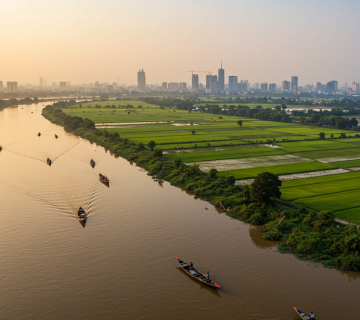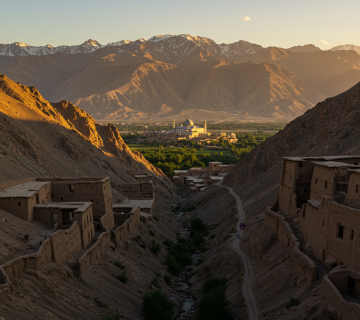China’s Geography: A Foundation for Regional and Global Influence
Spanning an immense and varied terrain—from snow-capped mountains to bustling coastal hubs, from arid deserts to fertile plains—China emerges as a continent-like nation within Asia. Its geographic diversity is not only a testament to its natural richness but also a critical driver of its economic development, regional influence, and global ambitions. Understanding China’s strategic geography is key to comprehending its political outreach and regional dominance.
1. Geographic Vastness and Natural Diversity
With an area exceeding 9.5 million square kilometers, the People’s Republic of China is the third-largest country in the world. Its landmass encompasses six distinct natural regions:
-
Northeast China: Known for its long, harsh winters, this region is home to heavy industries, forests, and vast mineral reserves.
-
Northwest and Western China: Dominated by the Gobi and Taklamakan deserts and mountain ranges such as Tianshan and Karakoram, these areas are rich in ethnic diversity and untapped resources.
-
Tibetan Plateau: Often called “the roof of the world,” this is the source of major Asian rivers and a vital ecological zone.
-
Central Plains: The cradle of Chinese civilization and agricultural heartland, historically home to many dynastic capitals.
-
Southern China: Hot and humid with dense population, this region thrives on rice cultivation and is home to fast-growing cities.
-
Eastern Coastal Areas: Economically dynamic, hosting megacities like Shanghai and Guangzhou, these zones are hubs of global trade and industrial power.
This vast natural diversity allows China to be largely self-sufficient and offers a range of development paths across different terrains and climates.
2. Borders and Regional Connectivity
China shares land borders with 14 countries, the most in the world, including Russia, India, Pakistan, Kazakhstan, North Korea, and Vietnam. These borders are not just geographic lines, but frontiers of diplomatic engagement and security management.
To the west, China reaches into Central Asia, forging transport corridors and energy pipelines as part of its Belt and Road Initiative. In the south, its border with India remains sensitive, particularly around regions like Tibet and Ladakh. In Southeast Asia, China’s economic and strategic reach interacts—and sometimes collides—with neighboring interests.
3. China’s Regional Role in Asia
China is the leading economy in Asia and the second-largest globally. It plays a central role in shaping the region’s economic architecture through initiatives and institutions such as:
-
Shanghai Cooperation Organization (SCO)
-
Asia-Pacific Economic Cooperation (APEC)
-
Asian Infrastructure Investment Bank (AIIB)
Through the Belt and Road Initiative (BRI), China has invested heavily in infrastructure projects across Asia, connecting its economy to those of Central Asia, South Asia, and Southeast Asia. This has expanded China’s economic footprint and created a web of strategic partnerships that extend far beyond its borders.
4. The South China Sea and Regional Disputes
The South China Sea is a geopolitically volatile region due to its rich natural resources and strategic shipping routes. China has claimed significant portions of this maritime zone and constructed artificial islands equipped with military infrastructure.
These moves have raised concerns among Southeast Asian neighbors such as the Philippines, Vietnam, and Malaysia, and have drawn international attention. Despite diplomatic tensions, China continues to assert its presence in the region using a combination of military posture and economic incentives.
5. Natural Resources and Infrastructure Development
China is abundantly endowed with coal, iron ore, copper, rare earth elements, oil, and natural gas. These resources underpin its industrial might and technological ambitions.
The Chinese government has implemented massive infrastructure projects to leverage these assets. High-speed rail networks, smart cities, modern ports, and megaprojects like the Hong Kong–Zhuhai–Macau Bridge or the Beijing–Shanghai high-speed rail illustrate the country’s focus on connectivity and modernization. These efforts not only support internal cohesion but also enhance China’s logistics and trade influence globally.
6. Global Presence and Strategic Calculations
China’s influence extends well beyond Asia. As a permanent member of the UN Security Council and a prominent player in the G20, China actively seeks to reshape global governance. Its promotion of alternative financial structures, such as the BRICS Bank and the Cross-Border Interbank Payment System (CIPS), reflects its long-term strategy to reduce dependency on Western institutions.
China’s foreign policy emphasizes “peaceful development” and “non-interference,” while leveraging economic investments, cultural exchanges, and technological outreach to expand its global soft power—particularly in Africa, Latin America, and the Pacific.
Conclusion
China’s vast geography and rich natural resources have not only fostered domestic growth but also empowered its role as a key regional and global actor. Through strategic connectivity, economic initiatives, and careful diplomacy, China has transformed its geographic advantage into a dynamic tool of influence. As the world navigates new geopolitical realities, China’s territorial scale and regional engagements continue to define its place in the international order.





No comment